The common belief that slavery in ancient Rome suppressed innovation overlooks a critical part of history. Roman slaves were often seen merely as laborers, but many were skilled inventors and contributors to technological progress. Their knowledge and creativity played a significant role in advancing Roman industry and daily life.
This article, How Roman Slaves Became Inventors: Stories of Innovation from the Shadows, sheds light on the overlooked contributions of Roman slaves and freedmen. It explores how these individuals not only operated within the confines of servitude but also drove invention and efficiency through their expertise. From mechanical devices to entrepreneurial ventures, stories of innovation by slaves reveal a complex dynamic where creativity thrived despite social constraints.
You will discover examples that challenge traditional narratives about slavery’s impact on innovation, highlighting the ingenuity emerging from unexpected quarters in ancient Rome.
The trade and economy in ancient Rome, which were foundational to its vast empire, significantly influenced both daily life and long-term stability. Understanding these intricate systems reveals the significance of economic practices that shaped one of history’s most powerful civilizations.
Moreover, the legacy of Roman law continues to influence modern legal structures across the globe. This enduring impact is a testament to the sophistication of Roman governance and its far-reaching implications.
In addition to law and economy, the artistic achievements during this period also reflect the empire’s vast reach and its ability to assimilate and innovate. The masterpieces of Roman art serve as a timeless legacy, showcasing aesthetic values intertwined with social, political, and cultural dynamics.
However, it is crucial to acknowledge that this era was not without its challenges. The decline of the Western Roman Empire serves as a stark reminder of how political instability and weak leadership can undermine even the most powerful civilizations. As one of history’s most formidable empires, Rome’s downfall was not merely the result of external invasions but rather a complex interplay of internal strife and ineffective governance.
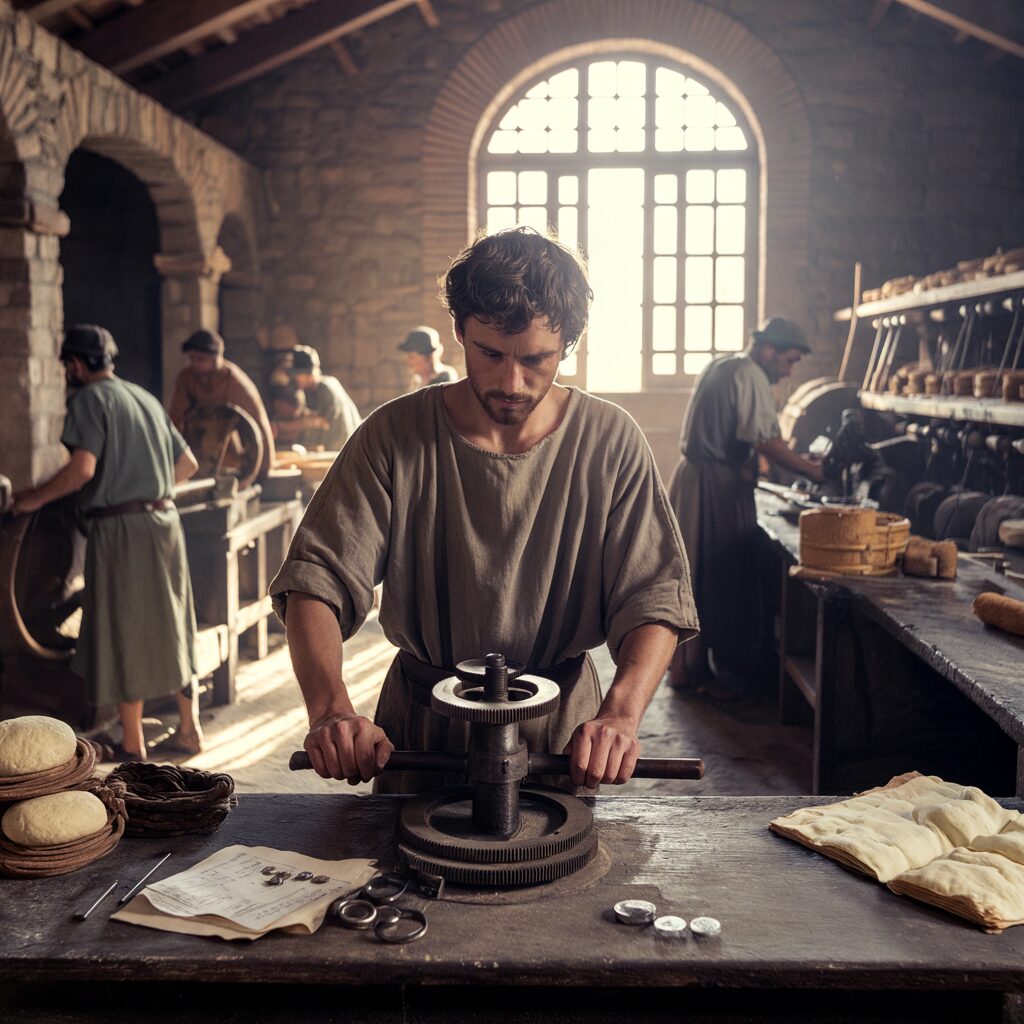
The Skilled and Educated Nature of Roman Slaves
Roman slaves were far from the simple, unskilled laborers often imagined. Many were skilled slaves and educated slaves, possessing knowledge and abilities that rivaled free citizens. This was not accidental but a result of deliberate slave training and education aimed at maximizing their utility.
Why Owners Invested in Slave Education
Owners had strong incentives to invest in the education and skill development of their slaves. A well-trained slave could perform complex tasks, manage workshops, or even oversee other workers, increasing productivity and the owner’s profits. Education ranged from literacy and numeracy to specialized technical knowledge, reflecting the diverse roles slaves held in Roman society.
Examples of Specialized Skills Among Slaves
Examples of specialized skills among slaves include:
- Craftsmen: Blacksmiths, potters, and carpenters who created goods for both local use and export.
- Engineers: Individuals skilled in mechanics who contributed to designing water systems, mills, and automated devices.
- Artisans: Sculptors, painters, and musicians who provided cultural value alongside practical work.
These roles show that many slaves were integrated into professions requiring significant expertise. The presence of highly educated slaves challenges simplistic views of slavery as purely manual labor. Instead, Roman education extended into the servile population to cultivate talents beneficial to economic enterprises.
This intricate structure of skill and education among slaves can be likened to the Power and Strategy of the Roman Military, which was also a well-oiled apparatus combining discipline, strategy, and innovation.
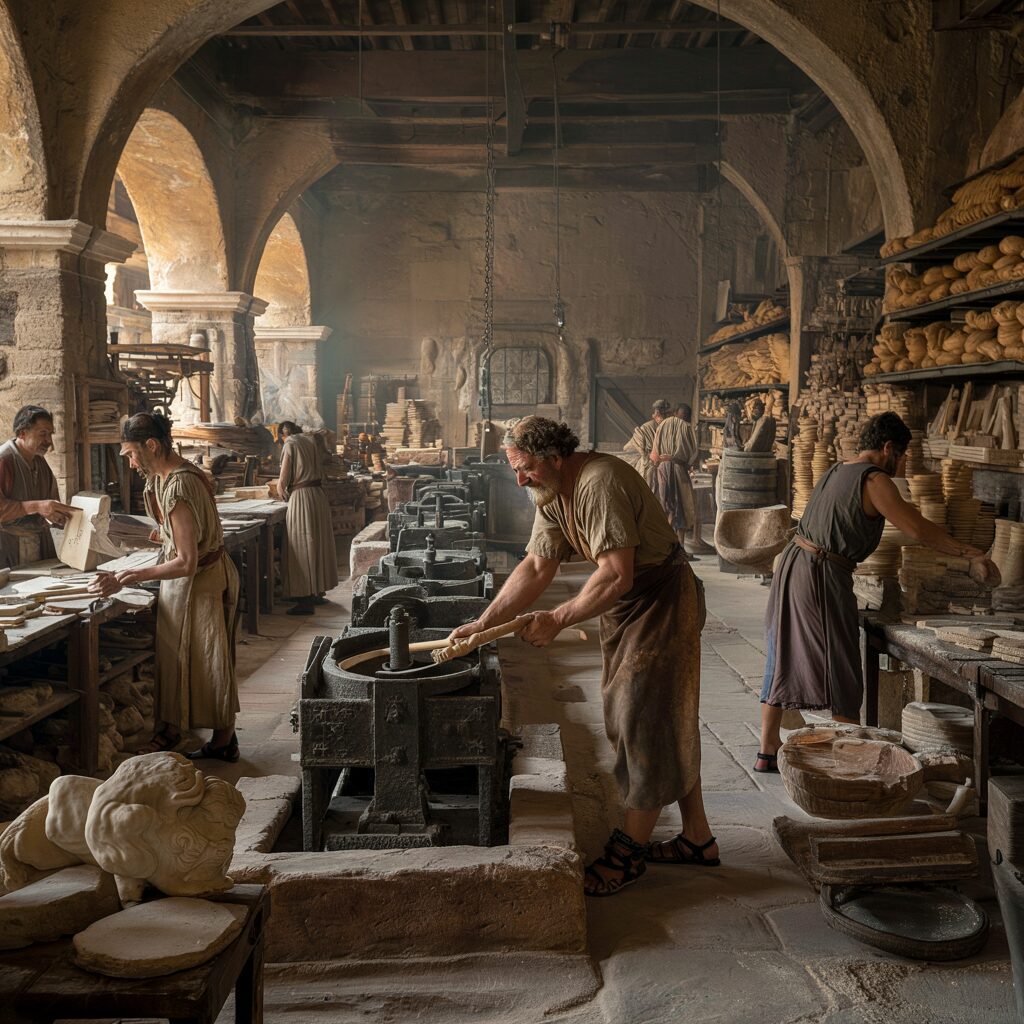
Technological Innovation in Slave-Operated Enterprises
In Ancient Rome, there were complex industrial enterprises where slaves worked alongside machines, creating a system that combined human skill and technological innovation. These slave-operated factories were more than just workshops; they were production centers that used automation to increase output.
Examples of Technological Innovation
One of the most notable examples can be found in the bread factories of Pompeii. In these establishments, slaves operated dough-kneading machines—mechanical devices specifically designed to make labor-intensive tasks easier. These machines utilized either water power or manual mechanisms to mix dough more efficiently than by hand. Slaves received training in both operating and maintaining these machines, ensuring their smooth operation at all times. This combination of human supervision and mechanization led to greater production and consistent quality.
How Technology Improved Efficiency
Technology in these factories improved efficiency in several ways:
- Reduced physical strain on workers, allowing them to work longer hours without getting tired.
- Increased speed and consistency in repetitive tasks such as kneading or milling.
- Enabled factory owners to expand production to meet the growing demands of cities.
The Role of Slaves in the Factory System
It’s important to note that automation did not eliminate the need for slave labor; instead, it changed their responsibilities. Slaves became operators, technicians, and supervisors of machinery, making them essential to the success of the factory. This relationship between human labor and technology demonstrates an advanced approach to production that was uncommon for its time but crucial in Roman economic life.
Economic Influences on Slave-Operated Enterprises
Interestingly, the success of these businesses was also affected by larger economic factors. For instance, emperors used coins as propaganda to convey their power and legitimacy. Additionally, the values and beliefs represented in the Roman Pantheon, including those related to authority, fairness, and wisdom, played a significant role in shaping the social environment where these slave-operated enterprises flourished.
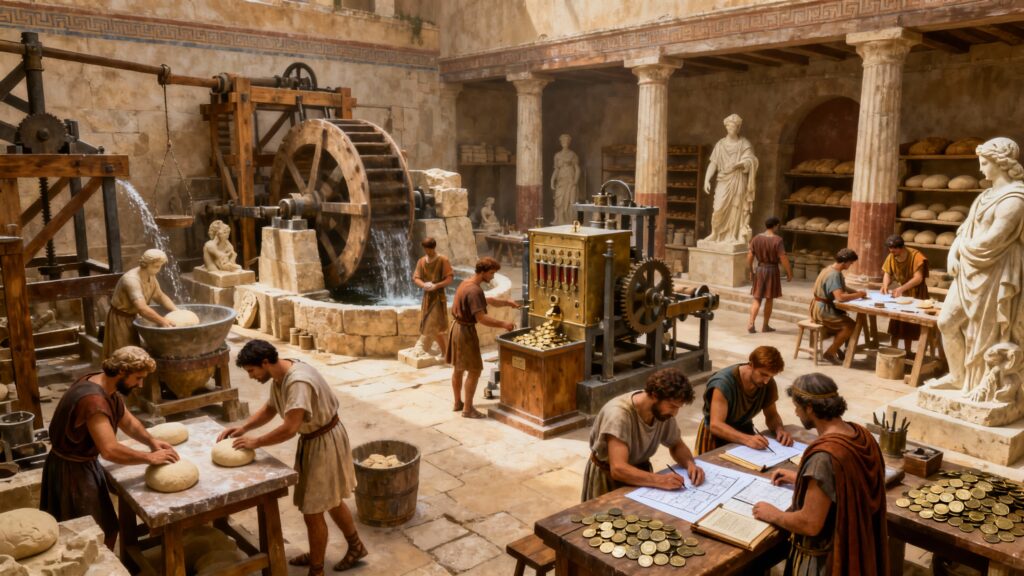
Economic Incentives Encouraging Slave Innovation
Roman economic structures included incentives designed to boost slave productivity and reward ingenuity. One key mechanism was manumission—the formal granting of freedom to slaves who demonstrated exceptional skill or loyalty. This system extended beyond full freedom, often creating a semi-indentured status, where slaves gained limited autonomy while still linked economically to their former masters.
1. Manumission as motivation
Slaves aware of potential freedom had strong reasons to innovate and improve their work methods. This created an environment where inventive thinking was not only tolerated but encouraged.
2. Freedmen entrepreneurs
Upon gaining freedom, many former slaves became business operators, managing workshops or commercial ventures. These freedmen served as intermediaries between elite owners and the broader market economy.
3. Mutual benefits
Freed slaves running businesses increased profits for themselves and their former owners through shared financial interests. This symbiotic relationship fostered further technological and organizational advancements.
Economic incentives shaped a culture where innovation emerged from practical needs and entrepreneurial ambitions within the constraints of servitude. The drive for manumission and profit encouraged slaves to develop new tools, processes, and methods that enhanced productivity—showing how How Roman Slaves Became Inventors: Stories of Innovation from the Shadows reflects deeply rooted economic realities rather than mere exceptions.
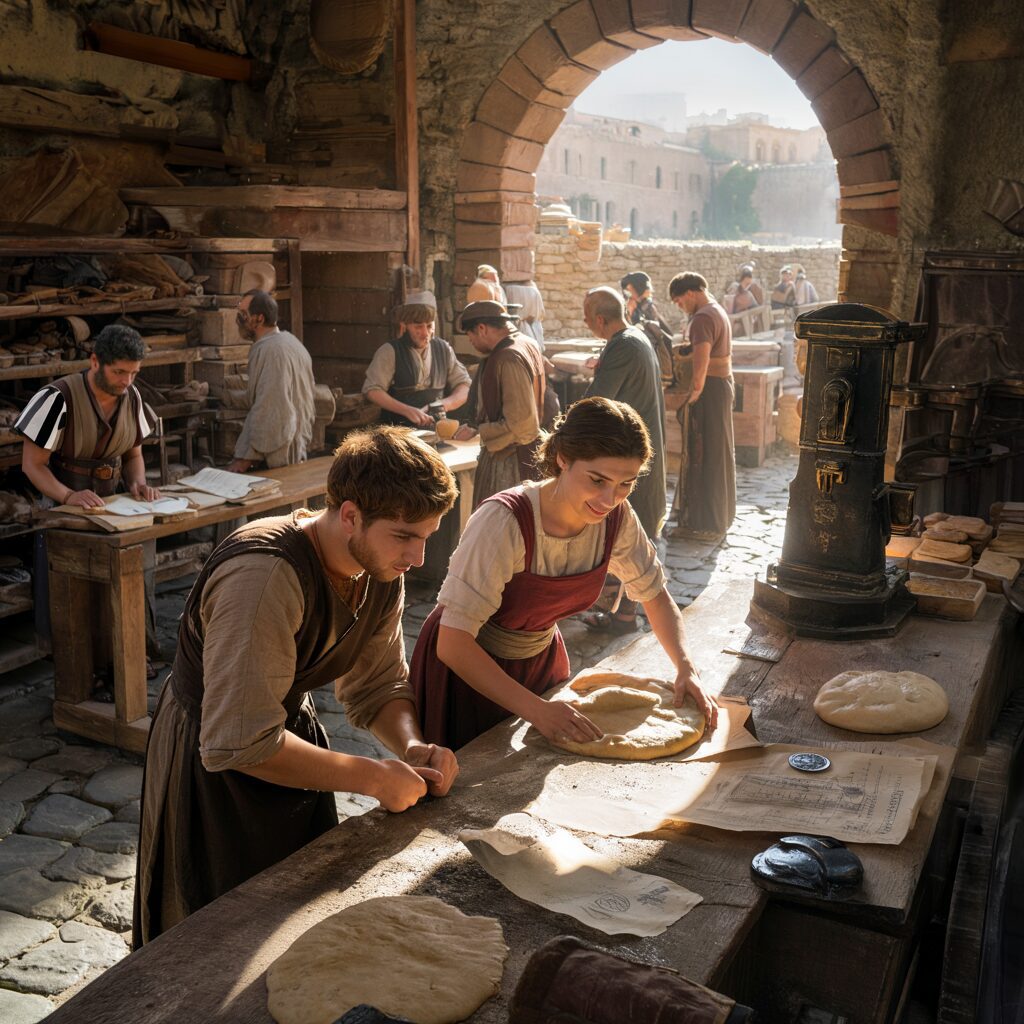
The Integration of Intellectuals and Craftsmen in Roman Society
The distinction between Roman scientists, engineers, and craftsmen was often far from clear-cut. In ancient Rome, theoretical knowledge and practical skills existed in a dynamic partnership rather than as separate domains. This collaboration fueled continuous technological progress and innovation.
1. Hands-on Innovation
Hands-on innovation was a hallmark of Roman engineering. Many individuals who developed new devices or techniques were directly involved in their construction and operation. This practical engagement ensured that inventions were not just theoretical concepts but functional solutions tailored to real-world challenges.
2. Skilled Slaves in Workshops
Skilled slaves frequently occupied roles that blurred social boundaries, participating as both laborers and intellectual contributors within workshops and industrial settings. Their deep understanding of materials, mechanics, and processes enabled them to suggest improvements or develop new tools.
3. Environment of Experimentation
The environment encouraged experimentation. Craftsmen drew upon scientific principles while scientists tested their theories through hands-on application. This synergy cultivated an atmosphere where invention thrived.
Slaves with specialized training in engineering or craftsmanship were essential to this ecosystem. Their contributions often extended beyond mere execution to include design innovations that increased efficiency or introduced novel mechanisms. This integration of intellect and skill supported a continuum of advancement deeply embedded in Roman society’s fabric.
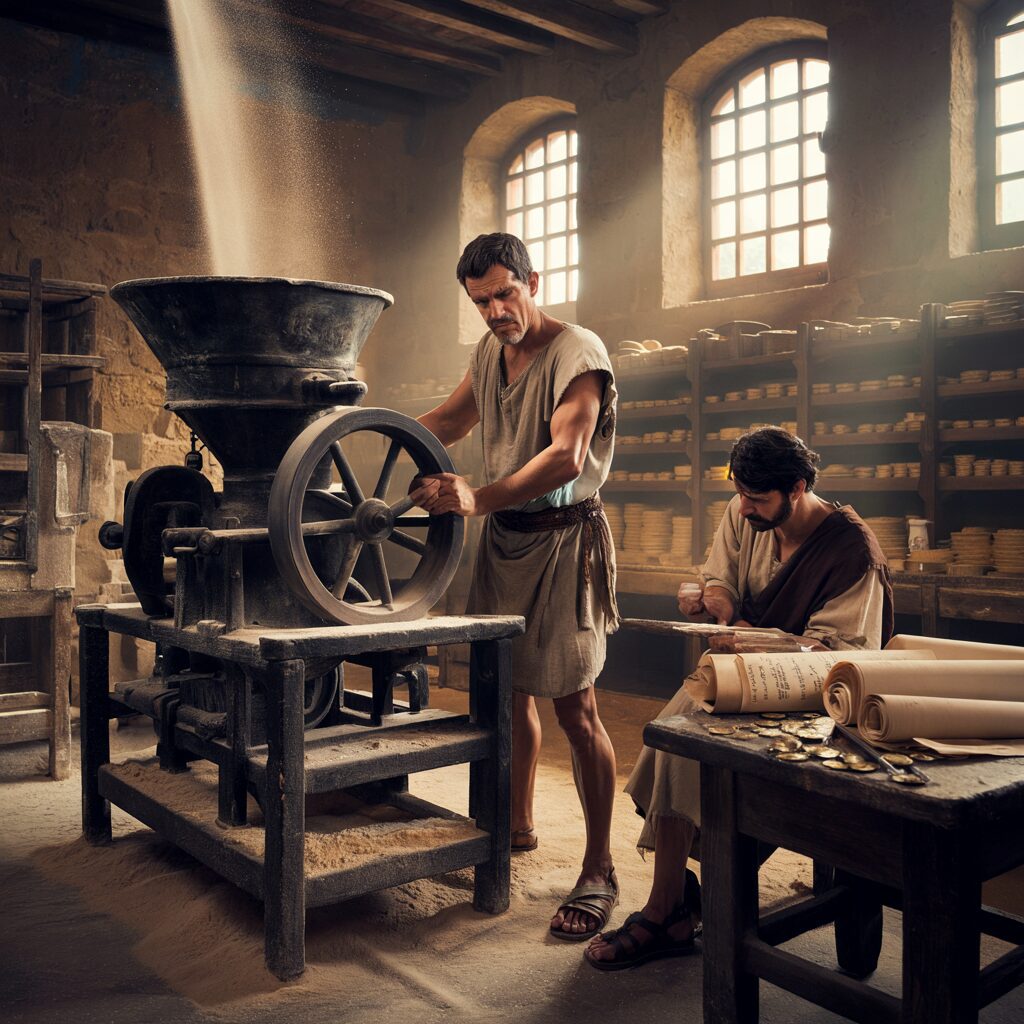
Notable Inventions Linked to Slaves and Freedmen
Roman innovation includes remarkable examples tied to individuals from servitude or lower social classes. Hero of Alexandria, a Greek engineer and mathematician living under Roman rule, created one of the earliest mechanized devices: a coin-operated vending machine designed to dispense holy water in temples. This invention allowed worshippers to receive a measured amount of water after inserting a coin, demonstrating an early form of automation aimed at improving efficiency and controlling resource distribution.
Hero’s work exemplifies how creativity and technical skill were not confined to elite Romans alone but emerged from a broader social spectrum that included slaves, freedmen, and craftsmen. The mechanization represented by this device aligns with other instances where slave labor combined with technology to increase productivity in various industries.
This vending machine reflects wider trends in Roman mechanization, where economic incentives pushed slaves and freedmen to develop tools and processes that enhanced operational efficiency. These innovations were more than simple labor-saving devices; they symbolized inventive responses to economic challenges within the constraints imposed by slavery. Hero’s inventions stand as testimony to how intellectual ingenuity flourished in unexpected quarters of Roman society, fueled by practical needs and facilitated by hands-on experience often gained through servitude.
The rituals and sacrifices associated with such holy water further illustrate the significance of Hero’s invention. Roman religious practices were deeply connected to the divine through these rituals, highlighting the cultural importance of the resources dispensed by his vending machine.
The Role of Slaves and Freedmen in Roman Economic Systems
The Roman economy thrived on a network of sophisticated financial practices that included banking systems, credit arrangements, and investment strategies. These mechanisms supported vibrant commercial activity across the empire. Wealthy elites often funneled capital into various ventures but relied heavily on intermediaries to manage these investments.
Freedmen, former slaves who had earned or been granted their freedom, occupied a critical role as business managers and entrepreneurs. Their unique position allowed them to bridge the gap between the elite investors and the day-to-day operations of commerce. Many freedmen controlled shops, workshops, and even larger enterprises, effectively running businesses that generated profits for themselves and their former owners.
Key features of this economic integration include:
- Credit practices: Freedmen frequently extended or managed credit lines, facilitating trade and production cycles.
- Business management: Skilled freedmen oversaw commercial ventures such as shipping companies, manufacturing, and retail outlets.
- Investment channels: Elites trusted freedmen to act as agents or partners in managing funds and expanding enterprises.
This system encouraged entrepreneurial activity among former slaves by providing incentives linked to profit-sharing and social mobility. The involvement of freedmen in economic roles challenged traditional social hierarchies while advancing innovation through practical business experience.
Moreover, this economic framework was part of a larger societal structure that has had a lasting impact on Western civilization. The influence of Roman society on modern life can be seen in various facets such as legal systems, architectural marvels, and cultural practices. The symbiosis between elite capital and freedmen management created fertile ground for new ideas and inventions to emerge from unexpected quarters within the Roman economy.

Reassessing Slavery’s Impact on Innovation in Ancient Rome
The traditional view that slavery inherently stifled creativity and technological progress in ancient Rome is increasingly questioned by modern scholarship on slavery. This perspective often overlooked the complex economic and social dynamics that shaped Roman industrial development. New research highlights several critical points:
- Slavery did not uniformly suppress innovation; many slaves were highly skilled and motivated by incentives such as manumission or improved living conditions.
- Owners invested in training and educating slaves to maximize productivity, which created an environment where skill cultivation was economically valuable.
- The relationship between slavery and innovation was deeply intertwined with Roman economic mechanisms, including business management by freedmen and the use of mechanization in slave-run industries.
This nuanced understanding recognizes slavery as part of a broader system that encouraged inventive thinking, not merely forced labor without intellectual contribution. The presence of economic incentives meant slaves could develop new techniques or devices that increased efficiency, benefiting owners and themselves. Such innovations contributed directly to the growth of Roman industry, from automated mills to complex manufacturing operations.
Modern research reframes slavery’s impact on innovation: it was not an obstacle but a component of an integrated economic structure fostering technological advances through practical knowledge, skillful labor, and entrepreneurial opportunities for freed individuals.
Conclusion
Roman slaves were more than just workers; they were innovators and inventors within a system that, despite its cruelty, offered unique economic incentives. Their impact on technology and business reveals a rich legacy of Roman slave inventors who shaped practical advancements through skill and creativity.
Recognizing this innovation from shadows invites a crucial historical reinterpretation, challenging the outdated view that slavery extinguished ingenuity. These stories highlight how marginalized groups have often been the hidden architects behind progress, deserving acknowledgment within the broader narrative of human achievement.
The journey into How Roman Slaves Became Inventors: Stories of Innovation from the Shadows opens new avenues for research. It urges you to explore further the untold accounts of resilience and brilliance emerging from unlikely sources—reminding us that innovation frequently thrives where we least expect it.
This sentiment resonates with the evolution of various fields during ancient Rome, such as in art, where Roman sculpture evolved significantly over time, showcasing a distinct focus on realism and the portrayal of power. These sculptures served not only as artistic expressions but also as instruments for political propaganda and religious devotion, reflecting the cultural, political, and social dynamics of ancient Rome.
FAQs (Frequently Asked Questions)
Did Roman slaves contribute to technological innovation in ancient Rome?
Yes, contrary to common misconceptions, Roman slaves were not merely laborers but also contributors to technological progress and invention. Many were skilled and educated, playing active roles in developing new technologies within slave-operated enterprises.
How were Roman slaves trained and utilized for skilled work?
Owners often trained and educated their slaves to increase productivity and value. This led to many slaves possessing specialized skills such as craftsmanship and engineering, enabling them to contribute significantly to technological advancements in ancient Rome.
What examples illustrate technological innovation within slave-operated enterprises in ancient Rome?
One notable example is the bread factories in Pompeii, where slaves operated dough-kneading machines. Such integration of mechanical devices enhanced efficiency in production facilities managed by slaves.
What economic incentives encouraged innovation among Roman slaves?
Roman economic systems provided incentives like manumission or semi-independence for effective slaves. Freedmen could run businesses benefiting themselves and former owners, fostering inventive thinking driven by the potential for economic reward and entrepreneurial opportunity.
How did the collaboration between intellectuals and craftsmen influence innovation involving Roman slaves?
In ancient Rome, the lines between intellectuals and craftsmen were blurred. Practical experience combined with theoretical knowledge created an environment where skilled slaves could meaningfully contribute to inventions and continuous technological progress.
Can you name notable inventions linked to Roman slaves or freedmen?
Hero of Alexandria, associated with servitude or lower social ranks, invented a coin-operated holy water dispenser—an early mechanized device. Such inventions exemplify creativity emerging from individuals connected to slavery or servitude in ancient Rome.

